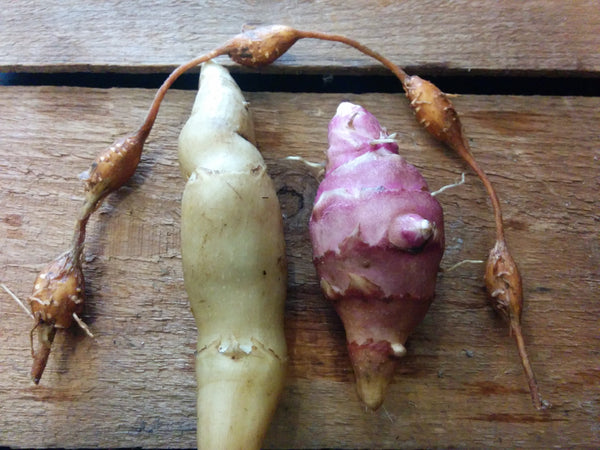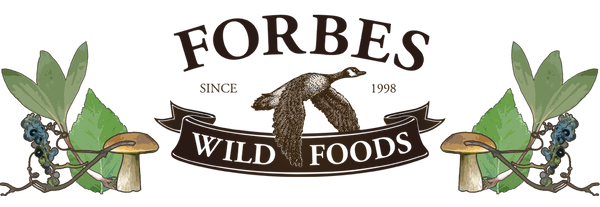Getting to Know Canada's Jerusalem Artichoke
•Posted on 九月 25 2020

Jerusalem artichokes (Helianthus tuberosus) aka Sunchoke or Girasole artichoke, grow across much of North America (naturalized in Europe) and are usually found in fields or meadows, preferring rich soil but capable of colonizing many habitats. In the fall, and even through the winter if the ground isn’t frozen solid, you can harvest large quantities of tubers. Since the plants frequently grow to over 10 feet in height, topped sometimes by a small yellow flower, they are easy to spot. Once a patch is established, it will just keep on growing. Those who have made the mistake of introducing them to their garden, then moving them around a few times, have discovered several patches.

These tall plants are similar looking to their relative, the sunflower, and nothing like green globe artichokes. They produce tubers that often resemble knobby potatoes, others that resemble smooth sweet potatoes. These were a very important food to first nations peoples and was among some of the first foods to be picked up by Europeans and brought back to Europe. After generations of being forgotten about, sunchokes are now seeing newborn popularity with chefs and home cooks. There are many different cultivars, including several developed by Native people in Northern Ontario that was hardy, early and had good-sized tubers.

The best time to dig the tubers is in the fall after the first heavy frost, because most of the tuber growth is late summer to middle fall. Take a shovel and a big basket, start at one side of the patch and start digging. After you have pried up a clump of earth, pull on the stalk. Often some tubers will be attached to the roots. Break up the clumps of earth and deposit the tubers in your basket. When you have a narrow trench started, get your hands into the earth and feel around for more tubers, usually just a few inches below the ground surface.

One plant can sometimes yield several pounds of tubers. Leave the small tubers in the soil and break any other small ones from the root and pitch them in as well. Each one of those small tubers will produce a big plant with lots of tubers next fall. My favorite patch freezes solid every winter but I am able to harvest some in April. Unlike regular potatoes, Jerusalem artichoke tubers are not affected by freezing and thawing. So you can leave them in the ground and get them whenever you want. If you decide to put them in your freezer, make sure that they are not washed and still have their dirt on them. For some reason this usually prevents them from going mushy when thawed. Generally, I keep about 5 pounds in the bottom of the fridge as well. Jerusalem artichokes stored for long periods of time will become sweeter as they age as they slowly convert carbohydrate inulin into fructose. Because people do not digest inulin very well fresh tubers, particularly from warmer climates, can lead to gas. It is often advised to pick after the first frost in autumn or before they have sprouted in spring and the let them rest for a few weeks before cooking.

When you get these tubers to your kitchen, take a few and wash well, using a brush to remove any stubborn bits of dirt, then dry them before putting in the fridge. Use your cleaned sunchokes within a few days as washed and cleaned of soil will reduce their shelf life.

Similar to other tubers such as potatoes, jerusalem artichokes are best cooked, however unlike potatoes they can also be eaten raw in salads or smoothies. Sliced thin, sunchokes can have a lovely crispness that is similar to a radish. Boiling the tubers can result in something mushy so often roasting is the preferred method for cooking as it helps add depth to the flavour by caramelizing some of the natural sugars.
More Posts
-
Get to know the mos...
Autumn is the absolute best time for mushrooms, after a year of growth the cool nights trigger mycelium to shoot out new fruiting bodies and the fo...
Read More





Comments
1 Comments
-

Posted by Scott Gillis | December 19, 2024
Leave a CommentJust did a quick search on where to buy these as I am constantly explaining what they are to people. Anyway, I found your interesting article and it echoes many of my experiences. Firstly, I grew up in the Annapolis Valley and recall, early in my life, my father bringing some of these from my mother’s parent’s garden in Clifton, New Brunswick on the Kennebecasis River. Within a very short time they were a Thanksgiving and Christmas dinner staple that everyone seemed to like (I come from a large family). As we moved away from our homes we missed them and my mother sent me some in the mail (to St. John’s, NL) one year which instead of eating, I dropped into the tiny garden in my backyard. As anticipated they thrived and I was quickly able to harvest them for my annual holiday dinners. My young family grew to love them and my youngest in particular craves them as I do. I have since shipped them to my brothers in Cape Breton and ironically back in New Brunswick where one lives across the river from the “original” source. He also got them from home over the years but in the area he lives the deer without exception mow down his little vegetable garden and these included. In Cape Breton on the gulf shore, they have gone crazy and grow 7 – 8 feet as well as maturing to flower each fall (I think mine only did that once in Newfoundland). The shipping directions you provide I eventually discovered as I ended up visiting my daughter and cooking some which went mushy when they thawed and the ones I sent to siblings the same until I left a little earth on them. I concluded that by the fact that they last all winter in the ground surrounded by mud and frost so maybe… Anyway, just nice to read from someone else who has knowledge of them. I found them in Sobeys here probably 40 years ago now under the name sunchokes – recognizing them immediately. Ate them in a high end restaurant here once more recently (Raymonds) and had to ask the chef where he got them. He indicate a local supplier but I haven’t seen them anywhere else either in a restaurant or a store. Always cook them the way Mum did – boil lightly until just done (or as you know they go to mush very quickly) and make a roux with onion powder and a pinch of ground cloves (I think Mum just made the white sauce). I guess the skin tone can vary. Mine are normally quite purple in tone. Oh, and always throw the peels back in the garden to propagate for next year.